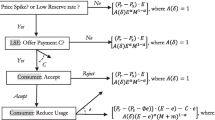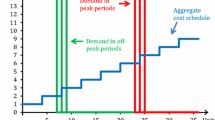Abstract
This article examines the participation of consumers in adjustment markets for electricity, which enable participants to respond to random supply shocks occurring after quantities have been contracted. If markets were perfect, opening the adjustment market to consumers would always increase ex post efficiency, hence welfare, as expected. In reality, some consumers hold private information on their value for electricity. We prove that under such information asymmetry, allowing consumers to participate in the adjustment market may reduce welfare. This arises because electricity suppliers in the model propose inefficient ex ante retail contracts to make them incentive compatible and to limit the information rents they must leave on the table for consumers to prevent them from misreporting their private information. If the value of ex post efficiency gains due to consumers’ participation in adjustment markets is low, whereas the information distortion is high, the overall net effect is a welfare decrease.
Similar content being viewed by others
Notes
Demand response is not demand management. In the latter, consumers buy electricity power at low price because they accept the risk to be disconnected by their provider. Ex post, they are not the decision maker. Oren (2013) presents a rich historical perspective of this type of arrangement. Interruptible contracts can be promoted by means of option mechanisms, as shown in Kamat and Oren (2002). Demand response is “A reduction in the consumption of electric energy by retail customers from their expected consumption in response to an increase in the price of electric energy or to incentive payments designed to induce lower consumption of electric energy.” (USCA 2012b).
See Laffont and Martimort (2002).
We are grateful to a referee for leading us to that clarification.
Note that the need for rebalancing could come from a unexpected increase in consumption. Consumers with low utility could also participate efficiently in the adjustment process.
For a given size of the shortage \(\mu \), the ranking of the missing plants in the merit order is indifferent. The marginal cost is just “shifted to the left” by \(\mu .\)
See the proof in Appendix 2.
See for example Laffont and Martimort (2002).
On the FERC case, see USCA (2012a, (2012b, (2014). We thank an anonymous referee of the Journal for the information about the recent overturn of the FERC decision by the US Court of Appeals for the D.C. Circuit Court. The Court first invokes legal reasons: “FERC can regulate practices affecting the wholesale market ..., provided the Commission is not directly regulating a matter subject to state control, such as the retail market.” Happily for the economist, it also refers to economic reasons: “Alternatively, even if we assume FERC had statutory authority to execute the Rule in the first place, [its Rule] would still fail because it was arbitrary and capricious”. And the Court explains that the FERC decision would overcompensate demand response resources because it requires that demand resources be paid the full marginal price plus be allowed to retain the savings associated with the provider’s avoided retail generation cost.
As Ruff (2002) says “Normal markets allow consumers to sell what they do not consume as long as they own it, but no rational market pays consumers for not consuming what they do not own, even if they can prove that they would have bought it but didn’t. Paying somebody because they might have bought more but didn’t is as illogical, unfair, and inefficient as buying the Brooklyn Bridge from somebody who thought about buying it but decided to sell it instead.” See also Crampes and Léautier (2012).
Demand response aggregators are not explicitly discussed in the above analysis. However, including them would only strenghten the insights: professional demand response aggregators may prove more apt than customers at strategically using private information. We are grateful to a referee for leading us to this observation.
The building of a load-reduction “merit order” based on priority service by aggregators is clearly exposed in Oren (2013).
For a good checklist, see Shapiro (1996).
This heterogeneity is not yet fully taken into account by suppliers. Chao (2012) shows that providing a menu of reliability-differentiated service options with compensatory insurance for curtailments is Pareto superior to undifferentiated service with uniform pricing. Smart grids will facilitate more diversification in the provision of energy services.
In September 2014, the French Competition Authority ordered GDF SUEZ, a big energy supplier, to grant its competitors access to parts of its database relating to consumers with regulated gas tariffs. The main argument is that the historical database and the marketing resources inherited from GDF’s former monopoly status are necessary tools for the new entrants to develop. See details at www.autoritedelaconcurrence.fr/user/standard.php?id_rub=592&id_article=2420.
See Tirole (2005) for an overview on competition policy in tying cases.
See Hogan (2009) on the PJM rules providing incentives for demand response.
Crampes and Léautier (2012) show the financial accounts concerned when rebalancing an energy shortage with a mix of additional production and demand reduction.
References
Borenstein, S., Jaske, M., & Rosenfeld, A. (2002). Dynamic pricing, advanced metering, and demand response in electricity markets. Center for the Study of Energy Markets, WP 105, University of California, Berkeley.
Chao, H. P. (2010). Price-responsive demand management for a smart grid world. The Electricity Journal, 23(1), 7–20.
Chao, H. (2012). Competitive electricity markets with consumer subscription service in a smart grid. Journal of Regulatory Economics, 41(1), 155.
Chao, H. P., & DePillis, M. (2013). Incentive effects of paying demand response in wholesale electricity markets. Journal of Regulatory Economics, 43, 265–283.
Crampes, C., & Léautier, T. O. (2012). Distributed load-shedding in the balancing of electricity markets, EUI RSCAS, WP 2012/40, Loyola de Palacio Programme on Energy Policy.
Deller, D., Giulietti, M., Jeon, J. Y., Loomes, G., Moniche, A., & Waddams, C. (2014). Measuring consumer inertia in energy. ESRC, Centre for Competition Policy, University of East Anglia, http://tiger-forum.com/Media/speakers/abstract/281405am/catherine_waddams.pdf.
Hogan, W. (2009). Providing Incentives for Efficient Demand Response, Electric Power Supply Association, Comments on PJM Demand Response Proposals, Federal Energy Regulatory Commission, Docket No. EL09-68-000, www.hks.harvard.edu/fs/whogan/Hogan_Demand_Response_102909.
Kamat, R., & Oren, S. (2002). Exotic options for interruptible electricity supply contracts. Operations Research, 50(5), 835–850.
Laffont, J. J., & Martimort, D. (2002). The theory of incentives: The principal-agent model. Princeton: Princeton University Press.
Oren, S. (2013). A historical perspective and business model for load response aggregation based on priority service. 46th Hawaii International Conference on System Sciences, http://www.ieor.berkeley.edu/~oren/pubs/I.B2.189.
Ruff, L. (2002). Economic principles of demand response in electricity. Washington, DC: Edison Electric Institute.
Shapiro, C. (1996). Antitrust in network industries, Address before the American Law Institute and American Bar Association, www.justice.gov/atr/public/speeches/0593.
Spulber, D. (1992). Optimal nonlinear pricing and contingent contracts. International Economic Review, 33(4), 747–772.
Stole, L. A. (2007). Price discrimination in competitive environments. Handbook of Industrial Organization, 3, 2221–2299.
Tirole, J. (2005). The analysis of tying cases : A primer. Competition Policy International, 1(1), 1–25.
Torriti, J., Hassan, M. G., & Leach, M. (2010). Demand response experience in Europe: Policies, programmes and implementation. Energy, 35(4), 1575–1583.
USCA (2012a). Economists’ Brief on FERC Order 745 regarding demand response compensation, Amici Curiae Brief, District Court of Columia Circuit. Electric Power Supply Association, June, Case #11-1486, Document #1378605, www.hks.harvard.edu/hepg/Papers/2012/Economistsamicusbrief_061312.
USCA (2012b). Reply brief of petitioneers, October, Case #11-1486, Document #1399196, www.publicpower.org/files/PDFs/ReplyBriefEPSAvFERC10112012.
USCA (2014). Electric Power Supply Association v. FERC, May, Case #11-1486, https://energylawprof.files.wordpress.com/2014/06/epsa-v-ferc.
Wilson, C. M., & Waddams Price, C. (2010). Do consumers switch to the best supplier? Oxford Economic Papers, 62, 647–668.
Acknowledgments
The authors thank two anonymous referees of the journal who have suggested important changes in the paper presentation.
Author information
Authors and Affiliations
Corresponding author
Appendices
Appendix 1: No demand participation in adjustment
Denote \(q^{*}\left( \theta ,\mu \right) \) the ex post efficient production, defined by equality of marginal value and marginal cost
Full differentiation of the above condition yields
since \(P_{q}<0\) and \(c^{\prime }\ge 0\). The optimal production decreases with the size of the shock \(\mu \). However, \(\left( q^{*}\left( \theta ,\mu \right) +\mu \right) \) increases with the shock \(\mu \).
Define \(\hat{\mu }\) the production shock such that \(c\left( q^{*}\left( \theta ,\hat{\mu }\right) +\hat{\mu }\right) ={\mathbb {E}}_{\mu }\left[ c\left( q\left( \theta \right) +\mu \right) \right] \). For \(\mu \le \hat{\mu }\), \( c\left( q^{*}\left( \theta ,\mu \right) +\mu \right) \le c\left( q^{*}\left( \theta ,\hat{\mu }\right) +\hat{\mu }\right) \) since \(\left( q^{*}\left( \theta ,\mu \right) +\mu \right) \) and \(c\left( .\right) \) are increasing. Thus
\(\Leftrightarrow \)
Appendix 2: Comparative statics on the adjustment market
Equilibrium:
Total differentiation:
or
Determinant of the full system:
Effects on \(p_{a}\):
Effects on \(q_{a}^{c}\):
Effects on \(q_{a}^{s}\):
Appendix 3: Welfare comparison in the linear case
Start from
Suppose the shock \(\mu \) is distributed according to a Bernoulli distribution: \(\mu =0\) with probability \(\left( 1-\beta \right) \), and \(\mu = \bar{\mu }\) with probability \(\beta \), hence \({\mathbb {E}}\left[ \mu \right] =\beta \bar{\mu }\). Then,
Introduce \(\gamma =\frac{b}{c}\) and \(\delta =\frac{\gamma }{1+\gamma }=\frac{ b}{b+c}\in \left( 0,1\right) \). Then, \(\lambda =\frac{\beta }{1-\beta }\frac{ c}{c+b}=\frac{\beta }{1-\beta }\frac{1}{1+\gamma }=\frac{\beta }{1-\beta } \left( 1-\delta \right) \), and \(1+\lambda =\frac{1-\delta \beta }{1-\beta }\) . Thus,
and
Opening the adjustment market reduces welfare if and only if \(\Delta W\left( x,y\right) <0\). Thus, we examine the sign of \(\Delta W\left( x,y\right) \). Consider \(\Delta W=0\) as a quadratic equation in y. Its discriminant is
where \(x_{0}=\frac{4\delta \left( 1-\beta \right) }{1-\alpha }\). If the information distortion is lower than \(x_{0}\), \(D\left( x\right) <0\), hence \( \Delta W\left( x,y\right) >0\): opening the adjustment market to load curtailment always improves welfare.
On the other hand, if \(x-x_{0}\) then \(D\left( x\right) >0\), \(\Delta W\left( x,y\right) =0\) admits two positive roots in y. Denote \(y_{1}\left( x\right) \) the smallest one, defined by
The largest root is
Thus, \(\Delta W\left( x,y\right) <0\) for \(x\ge x_{0}\) and \(y\in \left( y_{1},y_{2}\right) \), provided \(\left( 1+\lambda \right) x\le 1\ \)and \( x+y\le 1\).
A necessary condition is
which is condition (14).
If condition (14) is met, a sufficient condition for the existence of \({\mathcal {H}}\) is that \(f\left( x_{0}\right) =x_{0}+y_{1}\left( x_{0}\right) -1<0\). Then, by continuity, for \(x\ge x_{0}\) and close to \(x_{0}\), and \(y\ge y_{1}\left( x\right) \) and close to \( y_{1}\left( x\right) \), \(\Delta W\left( x,y\right) <0\), \(\left( 1+\lambda \right) x\le 1\), and \(x+y\le 1\).
We have
hence
This requires \(\left( 1-2\delta \beta \right) >0\) since the left-hand side is positive. Thus, if \(\left( 1-2\delta \beta \right) >0\),
which is condition (15).
Both conditions (14) and (15) place lower bounds on \(\left( 1-\alpha \right) \). Functional analysis proves that condition (14) is the binding one for low values of \(\delta \), then condition (15) becomes the binding one for higher values of \( \delta \).
Rights and permissions
About this article
Cite this article
Crampes, C., Léautier, TO. Demand response in adjustment markets for electricity. J Regul Econ 48, 169–193 (2015). https://doi.org/10.1007/s11149-015-9284-0
Published:
Issue Date:
DOI: https://doi.org/10.1007/s11149-015-9284-0




